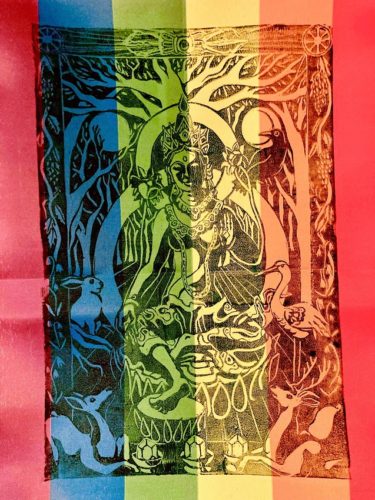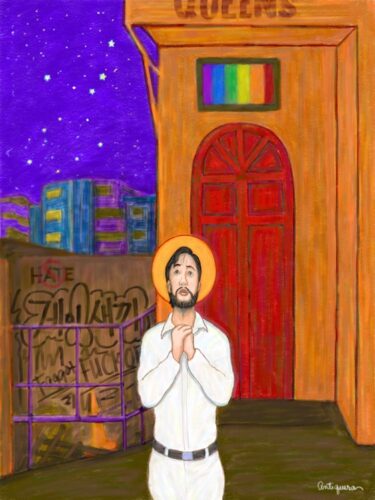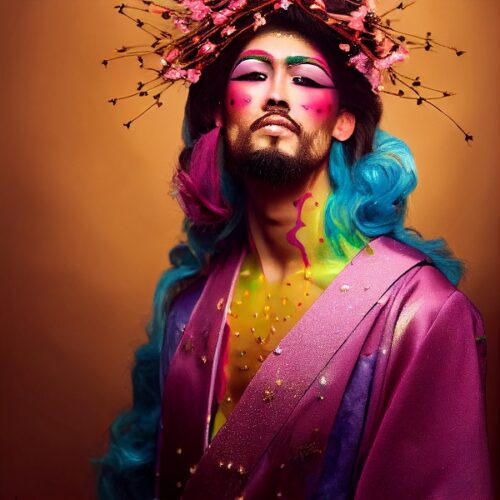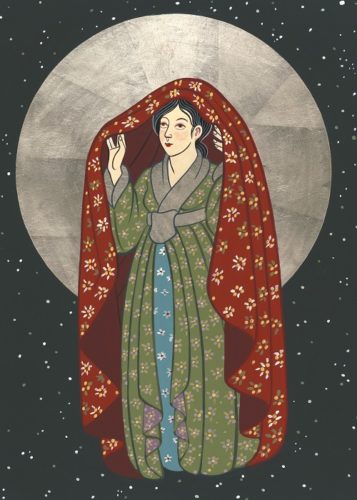Last Updated on July 24, 2024 by Kittredge Cherry

Kuan Yin, the genderfluid spirit of compassion in Buddhism, is sometimes thought of as a queer Christ figure or LGBTQ role model. Buddhists celebrate the enlightenment of Kuan Yin every year in July or August. This year the date is July 25, 2024.
Transcending gender identity, Kuan Yin appears in whatever form is necessary to help people in need: sometimes female, sometimes male, sometimes androgynous.
Christians honor Christ as savior, and Kuan Yin is a type of Buddhist savior figure called a bodhisattva — an enlightened person who is able to reach nirvana (heaven) but delays doing so out of compassion in order to save others from suffering.
Artists often show Kuan Yin with eyes in the hands and feet. They are like the wounds of Christ, but Kuan Yin can see with them. Kuan Yin is also associated with the mother of Christ. When Christianity was persecuted in Edo-era Japan, the “hidden Christians” created states of Mary disguised as Kuan Yin. Comparisons to Mary are more common than comparisons to Christ. For example, the Metropolitan Museum of Art in New York published the 2021 article, “Compassion, Mercy, and Love: Guanyin and the Virgin Mary: How two independent cultures—feudal Europe and imperial China—depicted divine figures with incredible visual similarities.”
Also known as the goddess of mercy, Kuan Yin goes by different names in different places, including Avalokiteshvara in India, Tara (female) or Chenrezig (male) in Tibet, and Kannon in Japan.
Writers and scholars who have explored the queer side of Kuan Yin include Patrick S. Cheng, an Episcopal priest who teaches at Chicago Theological Seminary; Hsiao-Lan Hu, religious studies professor at the University of Detroit Mercy; and Toby Johnson, a former Catholic monk turned author and comparative religion scholar.
New in 2024: Queer Asian Jesus prays alone in new artwork
A different kind of queer Asian Christ figure is portrayed in “Jesus Prays Alone” by Jason Antiquera, a Catholic missionary priest from the Philippines who works on mission in South Korea. He relocates the gospel story of Jesus praying alone in agony before his arrest. Instead of the garden of Gethsemane, the contemporary Asian Christ prays in Itaewon, an LGBTQ neighborhood in Seoul, South Korea.

“Jesus Prays Alone” by Jason Antiquera
Antiquera explained the connections when he introduced the digital artwork in a Facebook post in June 2024:
“This is a modern Gethsemane, not a garden, but street of clubs and bars where a lone man wrestles with an intrinsic problem: betray his identity or die. At the background are writings on the wall expressing hate and violence towards queer people with which Jesus is also grappling…. This scene symbolizes the struggles of LGBT people to reconcile their sexuality with their spirituality, to live as whole human beings even when church and society label them sinful or sick. In a world that often denies the value of queer lives, many LGBT people have felt utterly alone, trapped between denying themselves and confronting the “social death” of persecution and exclusion. Crouching in a back alley, the Jesus of today could be praying for a world where all God’s children are honored.”
His approach resembles “Jesus Prays Alone” from “The Passion of Christ: A Gay Vision” by New York artist Douglas Blanchard. Antiquera was also inspired by Vincent van Gogh’s “Café Terrace at Night.”
Kuan Yin as queer Asian Christ figure
In the introduction to his 2003 essay “Kuan Yin: Mirror of the Queer Asian Christ,” Cheng explains:
“Kuan Yin, the Asian goddess of compassion, can serve as a mirror of the queer experience. Specifically, Kuan Yin affirms three aspects in the life of queer people that are often missing from traditional images of the divine: (1) queer compassion; (2) queer sexuality; and (3) gender fluidity. In other words, Kuan Yin can be an important means by which gay, lesbian, bisexual and transgender people can see ourselves as being made in the image of God.”
Cheng writes clearly about the connection between Kuan Yin and Christ in the section where he describes his personal search for queer Asian Christ figures:
“I have been intrigued by the possibility of Kuan Yin serving as a christological figure for queer Asian people. For me, it has been difficult to envision the Jesus Christ of the gospels and the Western Christian tradition as being both queer and Asian (although I do recognize that queer theologians and Asian theologians have tried to do so in their respective areas). It is my thesis that Kuan Yin might serve as a symbol of salvation and wholeness for queer Asian people of faith….”
Click for the whole essay “Kuan Yin: Mirror of the Queer Asian Christ” in English or in Spanish.
Cheng’s latest book Rainbow Theology: Bridging Race, Sexuality, and Spirit was published in 2013. He is also the author of “From Sin to Amazing Grace: Discovering the Queer Christ”, “Radical Love: An Introduction to Queer Theology
.” His series on “Rethinking Sin and Grace for LGBT People Today” was one of the most popular stories of 2010 at the Jesus in Love Blog.
Kuan Yin moves beyond gender
Hsiao-Lan Hu presented a paper on “Queering Avalokiteśvara” at the 2012 American Academy of Religion annual meeting. She noted that the Lotus Sutra says that Avalokitesvara will appear to teach different beings in different forms, based on what they can accept.
In the summary of her paper, Hu writes, “Of the 33 forms listed in the Lotus Sutra, 7 are explicitly female, indicating that the Bodhisattva of Compassion transcends gender identity…. What is the theoretical ground in the Buddhadharma (Buddha’s teaching) that justify or even propel such conceptualization? How does that theoretical ground compare to modern-day queer theory?”
She summed up her paper in the 2013 Women’s and Gender Studies Newsletter from the University of Detroit Mercy:
“Avalokiteśvara’s multi-morphic manifestation affirms different beings in their specific identities, while his/her transformability points to the possibility of moving beyond the confinement of any particular identity. For people of minority identities, the Bodhisattva thus can be both a source of comfort and a model for coping with reality in which they often need to perform different roles.”
Hu is the author of This-Worldly Nibbana: A Buddhist-Feminist Social Ethic for Peacemaking in the Global Community.
“A nice myth for gay people”
Another LGBTQ perspective on Kuan Yin is provided by Toby Johnson in the preface to the revised edition of his book “Gay Perspective: Things Our Homosexuality Tells Us about the Nature of God and the Universe.” Johnson writes about Kuan Yin as the bodhisattva Avalokiteshvara:
___________
 “It is said there are Three Wonders of the Bodhisattva. The first is that he is androgynous, simultaneously both male and female, transcending the polarity of gender. That’s why he is such a sweet and lovable fellow: he blends the best of masculinity and the best of femininity.
“It is said there are Three Wonders of the Bodhisattva. The first is that he is androgynous, simultaneously both male and female, transcending the polarity of gender. That’s why he is such a sweet and lovable fellow: he blends the best of masculinity and the best of femininity.
The second wonder is that he sees there is no difference between nirvana and the life of suffering and rebirth in time, no difference between eternity and temporality, no difference between heaven and earth. This is why he could renounce his own nirvana and embrace all human experience. This life is nirvana; this is heaven on earth.
And the third wonder is that the first two wonders are the same!
That’s why this is such a nice myth for gay people to entertain. It says we’re really all One, all reflections of one another, that the distinction between male and female is illusory and needs to be transcended and that transcending gender is part and parcel with experiencing heaven now.
Avalokiteshvara is portrayed as the androgynous young being, beloved by everybody who knows him. That is very much like the ideal so many gay people find themselves looking for as a lover (and as a sense of themselves). And in the way that we gay people find the world a reflection of ourselves, so this myth says it really is. When we love another man or another woman, seeing their beauty and consciousness as like ours in homosexual attraction, that being we’re loving is the being that is ourself. No duality, no polarization.”
___________
A student of Joseph Campbell, Johnson has written 10 books, including the classic Gay Spirituality and Two Spirits
. He is former production manager of Lethe Press and former editor of White Crane Journal. Johnson discusses Kuan Yin as an androgynous figure who embodies compassion in his articles “Bodhisattva Avalokiteshvara” and “Avalokiteshvara at the Baths.”
Queer theologian Robert Shore-Goss applies the bodhisattva concept to queer Christian life in “Bodhisattva Christianity: A Case of Multiple Religious Belonging” in the 2013 book “Queering Christianity: Finding a Place at the Table for LGBTQI Christians.” Goss pastored Metropolitan Community Church in the Valley (North Hollywood, CA) after serving as chair of the religious studies department at Webster University in St. Louis.
Other queer Asian Christ figures
One of the few artists to explore queer Asian Christ figures is Jason Tseng, a Chinese American non-binary illustrator based in New York City. Tseng’s Queer Saints Project creates icons of queer ancestors.

Queer drag queen Christ by Jason Tseng, 2022
Contemporary icons that blend Asian and Christian iconography include “Korean Christ” by Robert Lentz, “Christ Sophia” by Br. Michael Reyes, OFM (Christ with Chinese characters and lotus blossom), and “Vincent Van Gogh: Peasant” by Lewis Williams (Van Gogh with Japanese characters and lotus blossom).
The queer Asian Christ also resonates in translations of the Rainbow Christ Prayer into various Asian languages. The prayer matches the colors of the rainbow flag with the seven models of the queer Christ from Patrick Cheng’s book “From Sin to Amazing Grace: Discovering the Queer Christ.” Versions in Asian languages include:
Chinese: 彩虹基督禱文
Japanese: 虹色のキリストへの祈り
Korean: 무지개 그리스도 기도
Malay: Doa Kristus Sang Pelangi
Tagalog: Panalangin ng Bahagharing Kristo
Kuan Yin in art
A large Ming-Dynasty bronze sculpture of Kuan Yin was included in the art collection of Bayard Rustin, a civil-rights activist who was kept in the shadows because he was openly gay.
Images of Kuan Yin posted here were created by Tony O’Connell, Stephen Mead, and William Hart McNichols. Mead is a gay artist and poet based in New York whose work has appeared internationally in cyberspace, books, and galleries. His Chroma Museum website features more than 500 montage images from his series on historical LGBTI figures and allies.

“Olga’s Kuan Yin” by William Hart McNichols ©
McNichols is a New Mexico artist and Catholic priest who has been criticized by church leaders for making LGBTQ-friendly icons of saints not approved by the church. His icons have been commissioned by churches, celebrities and national publications.
 |
| “Avalokitishvara” by Tony O’Connell |
O’Connell is a gay artist based in Liverpool. Raised in the Roman Catholic tradition, he has been a practicing Buddhist since 1995. He creates an artwork celebrating Avalokitishvara / Kuan Yin every year on his/her birthday. Viewers who look closely at his painting here will see an eye in the palm of the Compassionate One’s hand.
“There is an amazing statue of Avalokiteshvara in a Liverpool museum with a text that explains how the mustache was painted over to alter his gender as the people who met the monks on the spice routes from India struggled with the idea of a manifestation of compassion being male and wanted to see him as female. It occurs to me that there are subtle ranges of the same personality between Avalokitishvara, Kuan Yin and Tara as one gender ambiguous enlightened mind,” O’Connell said.
He explains that Tara came into being in compassionate response to samsara, the cycle of birth and death: “There is a beautiful scripture that talks about how even with all his enlightened abilities to benefit living beings, Avalokiteshvara saw the suffering of samsara was almost beyond measure. His heart broke for living beings and he wept tears of compassion. When the first tear hit the ground a lotus flower grew up and blossomed to reveal Tara. Her first words as a Buddha were, ‘Do not weep- I will help you.’”
O’Connell also perceives Kuan Yin reflected in the life of Francis of Assisi, a Christian saint known for loving animals, hugging lepers, embracing poverty and praying for peace. “I see him not just as a saint but as wider and more inclusive than that, as an echo of the Bodhisattva Avalokitishvara – the Buddha of Compassion and also as a gender non compliant queer spiritual archetype who can be reclaimed and celebrated by marginalised minorities,” O’Connell explained when he created an image of Francis on a lotus throne with a rainbow and four arms representing the qualities of Avalokitishvara. It appears in Q Spirit’s profile of Francis of Assisi.
For more about Tony O’Connell and his art, see previous posts Reclaiming sainthood: Gay artist Tony O’Connell finds holiness in LGBT people and places and Olympics: Spiritual art supports Russia’s LGBT rights struggle.
Rainbow Tara could choose any gender
O’Connell affirmed LGBTQ people in 2021 by creating a linocut image of Tara and printing it on an actual rainbow flag made of fabric. The artwork appears at the top of this post. Tara is shown in a forest, inseparable from nature, with such authentic compassion that even the wild animals gather to listen.
The artist was drawn to Tara as a being who could choose any gender, but vowed to be reborn as female until the end of the world. O’Connell explains in depth:
The scripture that first attracted me to this remarkable deity describes her life before Her Enlightenment when She was still called Wisdom Moon. She was meditating when some monks passed by Her and were impressed by the level of spiritual energy She was emanating. Possibly without meaning to sound arrogant but defaulting stupidly to their learned cultural expectations they said that they hoped she would attain male rebirth in Her next Life so She could become a Buddha. She was very far advanced of their understanding of reality and recognising that gender is a conditioned illusion. She answered them quite forcefully, saying-
“In this world there is no man, There is no woman. There is no person, self or consciousness. Man and woman are merely imputed and have no essence; thus the minds of worldly beings are mistaken!”
She then vowed to always choose female rebirth until she attained full Buddhahood. It is for this reason that she stands not only as a powerful feminist symbol but also as a protector against homophobia and transphobia.
The full text of Tara’s vow is:
“There are many who wish to gain enlightenment
in a man’s form,
and there are but few who wish to work
for the welfare of living beings
in a female form.
Therefore may I, in a female body,
work for the welfare of beings
right until Samsara has been emptied.”
The Rainbow Tara print is available with various options at his Hallowed Prints shop on Etsy.
“When living beings suffer…”
Kuan Yin is honored in the Lotus Sutra, one of the most popular and influential Buddhist sutras (scriptures). It inspired Q Spirit supporter Ernesto Borges Torres to write a meditation that begins with these lines about Kuan Yin:
The Awakened affirm:
If living beings are in need of experiencing salvation
from a Buddha or other spiritual leader,
from a goddess or a god, king or queen,
wealthy person, householder or politician,
from a lay woman or lay man, nun or monk,
woman or man or girl or boy,
from a dragon, demon, human or non-human being;
the Great Bodhisattva Responder to the Cries of the World
will appear in our bodies to liberate such living beings from suffering.
When living beings suffer adversity, sorrow and pain,
the Bodhisattva Responder to the Cries of the World,
by means of the power of Her manifest Wisdom,
is able to liberate them from the miseries of this world….
Kuan Yin discussed on social media
Multiple in-depth discussions of this post can be seen on Facebook here with various people adding valuable background info on Kuan Yin and his/her/their many incarnations:
___
Top image credit:
“Rainbow Tara” by Tony O’Connell
___
This post is part of the LGBTQ Saints series by Kittredge Cherry. Traditional and alternative saints, people in the Bible, LGBTQ martyrs, authors, theologians, religious leaders, artists, deities and other figures of special interest to lesbian, gay, bisexual and transgender and queer (LGBTQ) people and our allies are covered.
This article was originally published in August 2017, was expanded with new material over time, and was most recently updated on July 24, 2024.
Copyright © Kittredge Cherry. All rights reserved.
Qspirit.net presents the Jesus in Love Blog on LGBTQ spirituality.




















Thanks Kittredge for assembling all these resources. So helpful!
Hello! A friend forwarded your article to me to tell me I am quoted. I will be happy to send you my latest publication about Kuan Yin if you give me your email.
It’s great to hear from you! I would love to have your latest publication on Kuan Yin, so I will send you my email address.